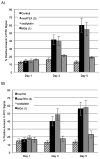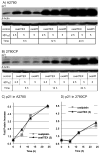A texaphyrin-oxaliplatin conjugate that overcomes both pharmacologic and molecular mechanisms of cisplatin resistance in cancer cells
- PMID: 23936624
- PMCID: PMC3737007
- DOI: 10.1039/C2MD20206A
A texaphyrin-oxaliplatin conjugate that overcomes both pharmacologic and molecular mechanisms of cisplatin resistance in cancer cells
Abstract
A texaphyrin-oxaliplatin conjugate, oxaliTEX, was designed to test the concept that a platinum analog can overcome defects in drug accumulation and p53-dependent DNA damage response in a tumor model expressing multifactorial mechanisms of cisplatin resistance. Cytotoxic studies resulted in a resistance factor of only 1.2, which essentially indicated complete reversal of resistance in 2780CP cells expressing a factor of 22 with cisplatin. Unlike cisplatin, oxaliTEX accumulated and formed DNA adducts, stabilized and activated p53 at similar levels in both sensitive and resistant cells, and induced apoptosis in both models. The ability and importance of a designer drug, such as oxaliTEX, to overcome cisplatin resistance by targeting two dominant resistance mechanisms is discussed.
Figures









Similar articles
-
In vitro studies on the mechanisms of oxaliplatin resistance.Cancer Chemother Pharmacol. 2001 Nov;48(5):398-406. doi: 10.1007/s002800100363. Cancer Chemother Pharmacol. 2001. PMID: 11761458
-
A Pt(IV)-based mononitro-naphthalimide conjugate with minimized side-effects targeting DNA damage response via a dual-DNA-damage approach to overcome cisplatin resistance.Bioorg Chem. 2020 Aug;101:104011. doi: 10.1016/j.bioorg.2020.104011. Epub 2020 Jun 12. Bioorg Chem. 2020. PMID: 32599363
-
Functional Activation of Mutant p53 by Platinum Analogues in Cisplatin-Resistant Cells Is Dependent on Phosphorylation.Mol Cancer Res. 2017 Mar;15(3):328-339. doi: 10.1158/1541-7786.MCR-16-0257-T. Epub 2016 Dec 28. Mol Cancer Res. 2017. PMID: 28031409 Free PMC article.
-
Cisplatin and platinum drugs at the molecular level. (Review).Oncol Rep. 2003 Nov-Dec;10(6):1663-82. Oncol Rep. 2003. PMID: 14534679 Review.
-
Oxaliplatin: mechanism of action and antineoplastic activity.Semin Oncol. 1998 Apr;25(2 Suppl 5):4-12. Semin Oncol. 1998. PMID: 9609103 Review.
Cited by
-
Targeting Antioxidant Pathways with Ferrocenylated N-Heterocyclic Carbene Supported Gold(I) Complexes in A549 Lung Cancer Cells.Chem Sci. 2016 Feb 1;7(2):1245-1256. doi: 10.1039/C5SC03519H. Epub 2015 Oct 29. Chem Sci. 2016. PMID: 26918111 Free PMC article.
-
Toward multifunctional anticancer therapeutics: post-synthetic carbonate functionalisation of asymmetric Au(i) bis-N-heterocyclic carbenes.Chem Commun (Camb). 2020 Jul 21;56(57):7877-7880. doi: 10.1039/d0cc03339a. Epub 2020 Jun 10. Chem Commun (Camb). 2020. PMID: 32520019 Free PMC article.
-
Reduced texaphyrin: A ratiometric optical sensor for heavy metals in aqueous solution.Front Chem Sci Eng. 2020 Feb;14(1):19-27. doi: 10.1007/s11705-019-1888-y. Epub 2020 Jan 8. Front Chem Sci Eng. 2020. PMID: 37786429 Free PMC article.
-
Making molecules work - stories of supramolecular translation.Chem Sci. 2025 Jul 29. doi: 10.1039/d5sc90071a. Online ahead of print. Chem Sci. 2025. PMID: 40740747 Free PMC article.
-
Oxaliplatin Pt(IV) prodrugs conjugated to gadolinium-texaphyrin as potential antitumor agents.Proc Natl Acad Sci U S A. 2020 Mar 31;117(13):7021-7029. doi: 10.1073/pnas.1914911117. Epub 2020 Mar 16. Proc Natl Acad Sci U S A. 2020. PMID: 32179677 Free PMC article.
References
-
- Siddik ZH. Oncogene. 2003;22:7265. - PubMed
-
- American Cancer Society. Cancer Facts and Figures 2012. ACS; Atlanta, GA: 2012.
-
- Siddik ZH. Drug Resistance and the Tumor Suppressor p53: The Paradox of Wild-Type Genotype in Chemorefractory Cancers. In: Mehta K, Siddik ZH, editors. Drug Resistance in Cancer Cells. Springer Science; 2009.
-
- Siddik ZH, Hagopian GS, Thai G, Tomisaki S, Toyomasu T, Khokhar AR. J Inorg Biochem. 1999;77:65. - PubMed
Grants and funding
LinkOut - more resources
Full Text Sources
Other Literature Sources
Research Materials
Miscellaneous

